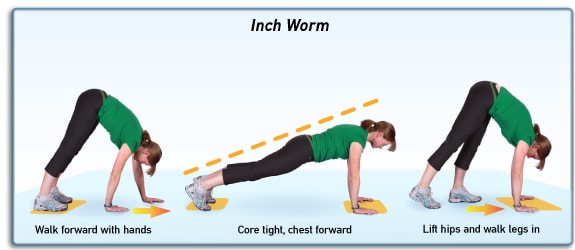These four stretches are exactly what Walter Norton, Jr., director of training at the Institute of Performance & Fitness in North Reading, MA, uses to gauge every new client’s flexibility—whether they’re a pro athlete, a celebrity or an average person looking to improve their fitness. Find out what your performance says about the state of your body.
The Spider-Man
What you’re testing: How flexible each hip is on its own
How to do it:
- Start in a pushup position, with your hands directly underneath your shoulders.
- Bring your left foot alongside your left hand and put your right knee on the floor.
- Dip your left shoulder towards the floor as you try to go deeper into the stretch. Hold for 2 breaths.
- Return to starting position and repeat on the other side, then continue for a total of 3 reps on each side.
You’ve got a problem if: There’s a big difference between how close to your hand you can bring the foot on one side compared to the other side.
The danger: A lack of flexibility often stems from a lack of strength, says Norton, Jr., meaning your less flexible hip is weaker than the other. Not only can that create serious balance issues, but other parts of your body may pitch in to compensate, too, working in ways that they’re not meant to work and leading to muscle fatigue in those areas. Both of those problems increase your odds of injury. Take weakness in your right hip, for example. It could mean you rely more on your left leg as you’re going about your day. Over time, if you don’t work to correct this, you may have more wear and tear on your left knee and ankle.
The Inchworm
What you’re testing: Hamstrings and calves
How to do it:
- From a push-up position, slowly start walking your feet toward your hands, taking tiny steps so your butt gradually goes up in the air.
- Walk your feet as far as you can without bending your knees.
- Take 3 breaths, then walk your hands forward until you are in push up position again.
- Repeat 3 times.
You’ve got a problem if: You can only take a few small steps, or you can’t get your feet past the spot where your knees were in the push-up position.
The danger: Tight calves and hamstrings are a sign that your range of motion in your legs isn’t what it should be. Norton, Jr. often sees this in treadmill runners, who tend to reach out with their feet instead of lifting their knees, overextending the muscles in the back of the leg. Limited range of motion also makes your back a prime target for injury, since your body will naturally take the path of least resistance as you go about your day, meaning instead of bending down to pick something up the proper way, you’re more likely to bend over and put unnecessary strain on your back.




